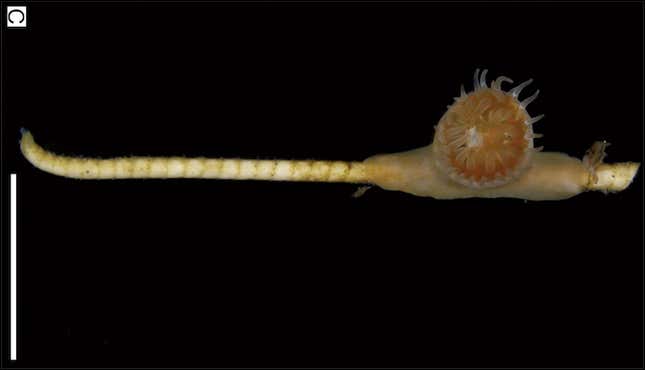
Off the southwest coast of Japan, a group of animals has been coexisting in a close relationship that researchers thought didn’t exist in the modern age. The team of researchers from Japan and Poland found a sea lily—which, despite its name, is an animal and not a plant—hosting coral and sea anemone species on its stalks, in an unexpected case of symbiosis. These creatures were last seen hanging out together in fossils that predate the evolution of the first T. rex, so the discovery that their friendship is alive and well was a happy surprise.
The 2-foot-tall Japanese sea lily is a crinoid, an animal related to sea urchins and starfish. The corals that call the lily home lack skeletons and share their space with Metridioidea, a type of sea anemone. In their new paper, published in the journal Palaeogeography, Palaeoclimatology, Palaeoecology, the research team describes how the corals and sea anemones attach to the sea lilies and grow off of them, a common interspecies collaboration in the deep sea Paleozoic, an age that ended a quarter of a billion years ago. But at the end of the Paleozoic, the fossil record for these animals coexisting ran cold.
According to Mikołaj Zapalski, a paleontologist at the University of Warsaw and lead author of the new study, the most recent fossil of crinoids and corals coexisting in this fashion is 273 million years old. Zapalski said that corals and crinoids are also found in fossil deposits younger than the Paleozoic (which ended some 250 million years ago), “but for unknown reasons they were never found together.” So the team was pretty stunned when they found the animals associating actively in the deep water off Japan.
Though sometimes less amicable—the animals can compete for food, the researchers wrote—the relationship has its benefits, as the corals can get higher off the seafloor and into stronger currents for feeding. The sea lily, the team determined, was likely not affected by the presence of its little hangers-on. Because the smaller critters have no skeletons, they likely rely on the sea lily’s branching structure to hold fast in the face of marine drifts.

The team used nets to collect specimens in Shikoku’s Sukumo Bay in 2015, turning up one of the coral polyps. Intrigued by the find, they searched other benthic habitats off the Japanese coast and ended up dredging the other specimens off the floor of Honshū’s Suruga Bay in 2019. They analyzed the specimens under a stereoscopic microscope. Under that lens, the sea lily’s stalks resemble metal rebar, standing firm for the gelatinous coral.
It may not be as flashy as the discovery of a new shark or glowing deep-sea fish, but the finding that this ancient relationship endures today is a reminder of how little we know about what goes on in the ocean.
More: Freakishly Tall Coral Reef Found Off the Coast of Australia